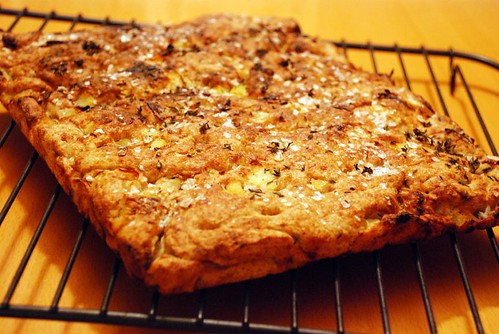
Focaccia is a really nice bread to make for dinner. It goes really well alongside a bowl of soup or salad, and it's great at a buffet table as well. I made this potato focaccia for my mom's birthday - Christmas, remember? - and it was a huge hit. No wonder - it's super tasty, with caramelized shallots and fresh thyme!
I baked it the day before and re-heated it a little before serving, to crisp it up. You could even underbake it a little bit, freeze it, and then heat it in the oven before serving. But it's best freshly made - then it will have a much crispier crust.
Potato Focaccia
25 g fresh yeast
250 ml water, tepid
1 tsp salt
300 ml wholemeal spelt flour (or wholewheat)
300 ml regular white wheat flour
3 shallots
2 tbsp rapeseed oil (or olive oil)
1/2 tbsp sugar
1/2 tsp salt
3 boiled potatoes, diced
flaky sea salt
fresh thyme
Crumble the yeast into a bowl. Add the water, and stir until the yeast has dissolved. Add both flours and the salt, and knead into a smooth dough. You can do it by hand, but I used my Kitchen-Aid. Move it to a clean bowl or board, cover and let it rise for 30 minutes.
Meanwhile, cut the shallots into small dice, and fry it in half the oil along with salt and sugar. They should caramelize lightly and turn golden. Let it cool.
Knead the shallots, diced potatoes and some fresh thyme into the dough. Use as much thyme as you like - a tablespoon or so is good. Press the dough into an oven tray, or a free form rectangle. Cover and let it rise for 30 more minutes.
Drizzle with the rest of the oil, and push your fingertips all over the surface to make little dimples in the bread. Sprinkle with flaky sea salt, and more thyme. Bake at 200°C for 25 minutes.
Recipe in Swedish:
Potatisfocaccia

5 comments:
When you say "fresh yeast," it's just the regular yeast we're after, not active, correct?
erin - regular, fresh yeast, the kind that's in the refrigerated section, not powdered, dry yeast. Although you could probably use that too in a pinch. I honestly don't know what "active yeast" means in relation to dry or fresh, as those are the only kinds we have here.
Gud vad gott jag älskar Focaccia
:-)
Hihi,
I love focaccia bread but never knew how to make it. Your post comes in handy. Will definitely give it a try. You have a nice blog too!
Thanks!
In the US (and I assume Canada) active dry or instant yeast is much easier to find than its fresh counterpart, and because of the short shelf life of fresh yeast most of the home-bakers I know do not keep it on hand.
The major difference between the yeast types is the number of living yeast cells per weight - fresh has the fewest, active dry has slightly more and instant the most. I had the hardest time tracking down a conversion from fresh yeast, but finally came across this formula from Peter Reinhart's "The Bread Baker's Apprentice" and it seems to work well:
100% fresh yeast = 40 to 50% active dry yeast = 33% instant yeast
So for any recipes using fresh just cut the measure roughly in half (erring on less) for active dry yeast, and only use a third for instant yeast.
Post a Comment